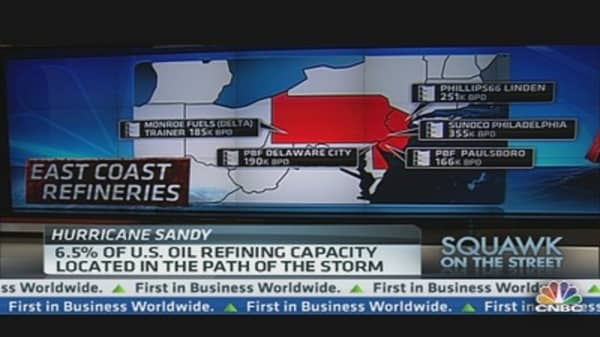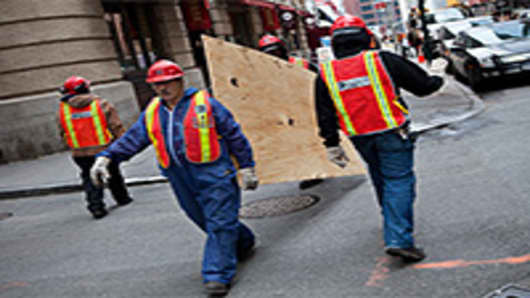While Hurricane Sandy is on its way to causing untold billions of dollars in damage, its impact on the stock market is likely to be isolated but unpredictable.
Exchanges across the U.S. closed Monday and will stay that way Tuesday as the potentially history-making storm stomps its way up the East Coast.
Futures traders made bets Monday that the stock market would open lower — about 48 points off on the Dow industrials — once trading resumes. (Read More: How the Decision to Close the Exchanges Came Down)
From there, though, the market action could be volatile.
"Investors have every reason to be on edge as they await the conclusion of natural, corporate, and political events," said Sam Stovall, chief equity strategist at Standard & Poor's. "Our belief is that November will be a month to remember."
Interestingly, Stovall said stocks usually rise in the aftermath of major storms.
Of the 13 worst hurricanes in U.S. history, only Ike in August 2008, which struck as the economy was entering freefall, and Hugo in 1989, saw stocks that were negative in the three-month and six-month intervals afterwards. The median six-month gains approached 6 percent.
"History says that hurricanes typically don't trigger market declines," Stovall said. "Individually, the market's performance following major hurricanes has been uneven, as equities are more likely driven by wider-reaching global events than localized natural disasters."
Still, Hurricane Sandy is likely to leave a mark.
The most obvious area would be on property and casualty insurers, which will have to wrestle with maybe $5 billion or more of claims. (Read More: Investors Are Already Bailing on Insurance Stocks)
Analysts at Bernstein Research expect some familiar names such as Travelers, Allstate and Chubb to take some early hits but ultimately rebound.
"As a longer-term investor, even with all the companies in our coverage likely to announce losses in coming days, we're just not that concerned, for the storm seems less powerful than broad, and even dramatic headline economic losses typically end up being much more muted insurable events," Bernstein's Josh Stirling and Michael Kovac said in a research note.
Following Hurricane Irene in August 2011, the insurer stocks traded down as much as 8 percent then recovered as damages became known and investors realized the companies could handle the losses.
"We can expect the market will continue to sell the stocks, given headlines and uncertainty, and then begin to buy them back when the companies report manageable losses," the Bernstein analysts said. "For many, this passing and predictable weakness presents an opportunity to build positions, now at more attractive levels, in the leading non-life writers to take advantage of a cyclical pricing recovery."
Retail stocks, particularly home improvement outfits like Home Depot and Lowe's, also will be in view. For those stocks, the reaction is often the opposite of the approach to insurers.
In the immediate aftermath of storms, "the market feasts on the enthusiasm but then any gains are given back once math is done that the actual impact to sales (less so earnings as storm precaution items are usually low-margin commodity-type goods) will be muted," Brian Sozzi, chief equities analyst at NBG Productions in New York, said in a report.
Sozzi had a few quick observations about what to expect from Sandy:
- Homebuilders such as Toll Brothers,D.R. Horton and Hovnanian could benefit from demand for rebuilding from the storm but are just as likely to get hit by damages to products, shell buildings and replacement costs.
- Amazon, which reported disappointed earnings last week, "has a long way to go in killing brick and mortar retail," evidenced when Sozzi did an online search for "hurricane preparation" and got no results for the online retailer. Outside of the online realm, Apple has 78 stores in Sandy's path.
- Much of the battle for post-storm business will come online. Sozzi found that Sears had a "surprisingly nice storm guide on its homepage," while Home Depot also had a "storm central" guide but Lowe's had none.
Commodities also will get plenty of attention.
Dennis Gartman, who runs a hedge fund and authors the widely followed Gartman Letter, said that space, too, will be a mixed bag. (Read More: Sandy Also Could Wreak Havoc With Oil Refineries)
"If Sandy becomes truly untoward in the next 48 hours, we can imagine crude oil prices coming under pressure while gasoline, and particularly heading oil, race higher," he said. "We can imagine the heating oil backwardation (future month prices lower than current) to become even more extreme than it already is, and we can imagine gasoline going backwardated out into the spring of next year rather easily. Indeed, we'd be surprised if it did not do so."
The good news is that, ultimately, the U.S. economy will rebound from the storm and even provide some chances for a quick stimulus.
University of Maryland economist Peter Morici pegged Sandy's total damages at least $35 billion, much of which will be offset by the economic benefits of rebuilding.
"Disasters can give the ailing construction sector a boost, and unleash smart reinvestment that actually improves stricken areas and the lives of those that survive intact," he said. "Ultimately, Americans, as they always seem to do, will emerge stronger in the wake of disaster and rebuild better — making a brighter future in the face of tragedy."






